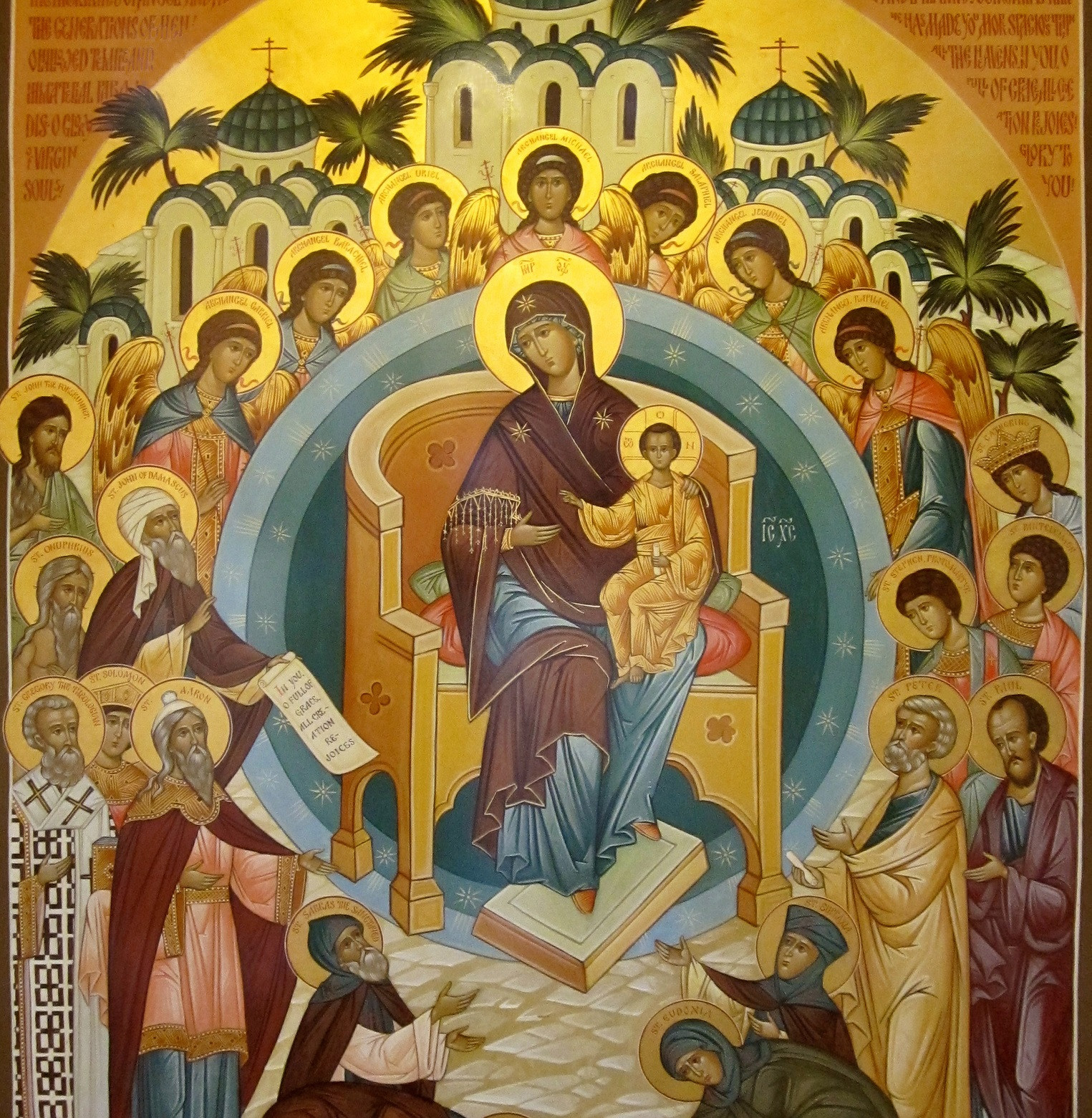Encouraging your congregation to actively participate in singing is vital for a vibrant worship experience. When people feel comfortable and understand the music, they are more likely to join in, creating a more unified and uplifting atmosphere. As we look forward to a time when congregational singing can be fully embraced once again, understanding the structure of the Responsorial Psalm each week becomes increasingly important. It’s about making everyone feel confident and ready to take part.
 Lady = Church scaring off dragon=Satan
Lady = Church scaring off dragon=Satan
Because the Responsorial Psalm isn’t a fixed form; it comes in various shapes and sizes. We’ve previously discussed psalm-lullabies, which, while comforting, generally adhere to a standard format. However, other types can significantly alter the familiar structure. The most common format is the verse and chorus model, a structure universally recognized from folk songs and even children’s Songs And Lullabies. This familiar structure, with changing verses and a consistent chorus, allows even newcomers to quickly learn and participate by the end of the song.
 Dinosaur in a snailshell
Dinosaur in a snailshell
Other liturgical traditions, like the Anglican style, often sing psalms straight through without a response or chorus. This method efficiently covers a larger portion of the Psalter and is easier to manage and practice. However, it often lacks the engaging congregational participation that a Responsorial Psalm encourages. Sometimes, choirs divide into sections, echoing the cathedral tradition of Decani and Cantoris, alternating verses of the psalms. While this creates a dynamic and engaging sound, reminiscent of early stereo effects, it doesn’t typically involve the congregation in singing.
Psalms as Sea Shanties: A Rhythmic Approach
 Jonah and whale
Jonah and whale
Interestingly, a few psalms and canticles adopt a poetic structure similar to sea shanties. Sea shanties, experiencing a surge in popularity, perhaps due to their suitability for remote rehearsals and their inherently robust, participatory nature, offer a unique rhythmic psalm experience.
In a religious context, we often refer to these forms as litanies. The principle remains similar to a sea shanty: a leader or small group sings a line of text that varies with each iteration, often unified by a theme, such as titles for Mary like ‘Rose of Sharon’ or ‘Star of the sea’. Following each of these varied lines, another person or group responds with a repeated line like ‘Pray for us’ or ‘Alleluia’. This call-and-response structure is effective for congregational singing because the repeated response line is easy to learn and join in on. This structure was used in the Mayfield Mass Kyrie, designed to ease congregational participation by requiring them to learn just one simple melodic line. The Agnus Dei from the same Mass inverts this structure, repeating the first half of the phrase three times and varying the second half, proving to be both effective and accessible for singers.
Verse and Chorus: Familiar and Engaging

The verse and chorus structure of the Responsorial Psalm, common in Catholic Sunday services, was a key inspiration for composing psalm tunes. It mirrors the structure of many traditional folk songs and nursery rhymes, forms deeply ingrained in our musical understanding from childhood. Children naturally grasp this call-and-response format, similar to learning turn-taking in conversation: “I say this; you answer that.” Many early musical memories are shaped by this structure, making these songs easy to learn and participate in, naturally encouraging communal singing.
Shapes Already in the Psalter
Considering the Book of Psalms as the Church’s original hymn book reveals its inherent design for congregational participation. The repetition and simple structures within the psalms themselves facilitate communal singing. The written text of the Psalms reveals various shapes, from litanies (Psalms 117/118, 134/135) to songs with choruses (Psalms 45/46, 48/49, 66/67). Some psalm structures are more apparent than others. Choruses are sometimes used to provide structure to longer psalms (like Psalm 79/80). It is plausible that some psalms with a shorter opening stanza were originally intended to be sung responsorially, with the initial stanza serving as a recurring response, as seen in Psalms 19/20, 83/84, and 127/128, as well as those starting with ‘Alleluia’. Psalm 106/107 even includes a suggested response in quotation marks. While the exact point of translation or editing when these were added remains uncertain, they suggest the intended use and shaping of these psalms for communal worship.
Shaping the Response
A challenge arises when the prescribed responses in the Lectionary feel too brief. In earlier times, church musicians freely repeated musical phrases, a practice now often discouraged. This brevity can sometimes unbalance the verse length. Furthermore, some responses simply lack musical or lyrical quality.
 Mary and choir of angels
Mary and choir of angels
Litanies, Shanties, and Group Participation
Litanies offer an even simpler structure than standard Responsorial Psalms, requiring less memorization. However, they demand greater engagement from the congregation, as they carry half of the musical weight. As the litany form might be less familiar for psalm singing, explaining the structure before Mass is beneficial, especially if it deviates from the typical verse and chorus. With sufficient initial understanding, newcomers can easily follow along. The alternating lines in a litany or shanty necessitate alertness and participation from all singers, contributing to their effectiveness as work songs. The older term ‘chanty’ hints at a possible link to Gregorian chant, suggesting a historical depth to this musical form. Whether or not that connection is accurate, sea shanties are indeed old, with roots possibly stretching back to ancient seafaring traditions. Modern adaptations, such as US Marines using shanty-like songs during runs, illustrate the enduring appeal of rhythmic, group-based singing for synchronization and motivation.

Unity Through Rhythm and Shared Song
The essence of these psalm forms isn’t necessarily about polished singing or intricate melodies, but about rhythm and collective unity. Consider the drummer in Ben Hur, the Hortator, setting the rhythm for the rowers. The rhythm is crucial for synchronizing effort, especially when physical exertion leaves little breath for singing. While slave rowers lacked a shared musical heritage, a free crew singing a sea shanty can work and sing in response, with the shantyman improvising while maintaining the rhythm, keeping the crew engaged. While improvisation isn’t typical in Sunday psalms, the principle of rhythmic unity remains.
Clarity and Simplicity are Key
Ultimately, any psalm structure can be effective if the congregation understands the form. The common verse and chorus structure is widely familiar. Variations in verse number and length are acceptable, provided the transition to the consistent response remains clear. Even using alternating tunes within a psalm, while maintaining the response, can work effectively. Confidence in leading and clear communication are essential. While current circumstances with smaller, masked congregations present challenges, nurturing the desire to sing is crucial. Brighter times for congregational singing are ahead.
© Kate Keefe and Music for Mass 2021. Used with permission.
Please follow and like us:
Author: Kate Keefe
Kate Keefe is a composer specializing in music for responsorial psalms and liturgical use within English-speaking Catholic congregations globally. Her work supports congregations in the UK, Ireland, Canada, Australia, New Zealand, the US, and the Philippines, aligning with local lectionaries. Beyond composition, she shares insights into her creative process and contributes to The Tablet with reflections on synodal processes, family life, and the role of women in the Church. View all posts by Kate Keefe
